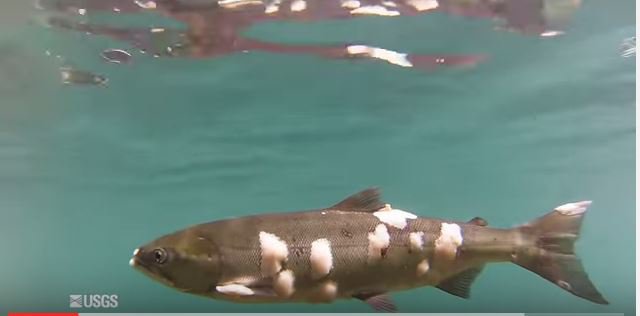Hot River, Dead Salmon, Lessons Learned
- April 15, 2016
- John Harrison

The summer of 2015 was disastrous for sockeye salmon migrating through the Columbia River. On their way home to the Okanagan and Wenatchee rivers in Washington, and the Snake River in Idaho, the fish had to pass through a lethally hot Columbia.
Beginning in late June and continuing through July, unusually low runoff from a below-average snow pack, combined with a lingering drought and hot weather, boosted the water temperature in the Columbia to intolerable levels for salmon. More than a quarter million sockeye died between Bonneville and McNary dams.
State fish and wildlife agencies and Indian tribes scrambled to find ways to cool the river, but for many fish, including endangered Snake River sockeye, it was too late. Fish that migrated on the edges of the heat wave, in early June and late July, fared better than the bulk of the run, but the result still was devastating. No Snake River sockeye that crossed Bonneville Dam after July 16 survived to Idaho, just 2 percent of the Okanagan sockeye counted at Bonneville made it home, but Wenatchee fish fared better perhaps because that river was a little cooler than other tributaries.
Last week, NOAA Fisheries, which directs river and dam operations under the Endangered Species Act, reported to the Council on the lessons learned from the summer of 2015, lessons that will prove useful in the future if predicted climate warming occurs and river conditions more frequently become dangerous for cold-water fish like salmon.
“All the Columbia tributaries were running brutally hot,” NOAA’s Ritchie Graves, chief of the Columbia hydropower branch, told the Council. Some tributaries in Idaho and Washington reached nearly 80 degrees; the Columbia reached 73 degrees, and the Okanagan hit 83. Anything over about 68 degrees stresses fish, and prolonged temperatures over 70 are lethal.
“Instances like this could occur more frequently in the future, and we need to prepare,” Graves said.
Probably the most important lesson from last year’s emergency is that decision-makers need to react faster to help the fish, he said.
“Last year we probably talked too much,” he said. ”It took days or weeks to talk through some of these things. People had the best interests of the fish at heart, but it all took too long.”
Russ Kiefer of Idaho Fish and Game, who joined Graves at the Council meeting, agreed. “Some of the operating changes took longer because we weren’t dealing with a lot of facts, we were depending on a lot of beliefs. The management community needs to be ready to act more decisively in an emergency like this,” he said.
Other lessons learned included:
- Adult fish ladder counts may be biased during high-temperature periods, as fish fall back through turbines or the ladders or stray in search of colder water downstream of the dam
- Fish ladder temperature monitoring and reporting could be improved
- Cold water releases from large storage reservoirs like those behind Grand Coulee and Dworshak dams reduced downstream river temperatures slightly, but the effect dissipated rapidly
- Truck transportation of adult sockeye from Lower Granite Dam appeared to be an effective “hedge” strategy for Snake River sockeye, one Graves called “a wise decision last year.”



